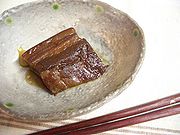
Kakuni
Encyclopedia

Kakuni is a meibutsu
Meibutsu
Meibutsu is a Japanese term for famous products associated with particular regions. Meibutsu are usually items of Japanese regional cuisine, although the category includes local handicrafts. Meibutsu typically have a traditional character, although contemporary products may qualify as meibutsu...
(popular regional product) of Nagasaki. The origin of this dish is most likely Chinese, making it a form of Japanese Chinese cuisine
Japanese Chinese cuisine
Japanese Chinese cuisine is a unique style of Chinese cuisine served by Chinese restaurants in Japan. Many of these restaurants are Japanese-owned, though there are some which are operated by overseas Chinese...
, and it is similar to Dongpo's pork
Dongpo's pork
Dongpo pork is a Hangzhou dish which is made by pan-frying and then red cooking pork belly. The pork is cut to around 2 inches square in dimensions, consisting of half fat and half lean meat. The mouth feel is oily but not greasy, with the fragrance of wine...
, though not as heavy in sauce. During the Ming Dynasty
Ming Dynasty
The Ming Dynasty, also Empire of the Great Ming, was the ruling dynasty of China from 1368 to 1644, following the collapse of the Mongol-led Yuan Dynasty. The Ming, "one of the greatest eras of orderly government and social stability in human history", was the last dynasty in China ruled by ethnic...
and Song Dynasty
Song Dynasty
The Song Dynasty was a ruling dynasty in China between 960 and 1279; it succeeded the Five Dynasties and Ten Kingdoms Period, and was followed by the Yuan Dynasty. It was the first government in world history to issue banknotes or paper money, and the first Chinese government to establish a...
, the main Sino-Japanese trading route existed between Hangzhou
Hangzhou
Hangzhou , formerly transliterated as Hangchow, is the capital and largest city of Zhejiang Province in Eastern China. Governed as a sub-provincial city, and as of 2010, its entire administrative division or prefecture had a registered population of 8.7 million people...
and Kyūshū
Kyushu
is the third largest island of Japan and most southwesterly of its four main islands. Its alternate ancient names include , , and . The historical regional name is referred to Kyushu and its surrounding islands....
. Many Chinese lived in major Kyūshū port cities, such as Nagasaki and Japanese in Hangzhou
Hangzhou
Hangzhou , formerly transliterated as Hangchow, is the capital and largest city of Zhejiang Province in Eastern China. Governed as a sub-provincial city, and as of 2010, its entire administrative division or prefecture had a registered population of 8.7 million people...
. Therefore pork was popularized in major Kyūshū cities.
Preparation
Kakuni is made of thick cubes of pork bellyPork belly
Pork belly is a boneless cut of fatty meat derived from the belly of a pig. Pork belly is popular in Asian cuisine, and forms a part of many traditional European dishes such as the Alsatian Choucroute garnie, the Swiss Berner Platte, and the German Schlachtplatte...
simmered in dashi
Dashi
Dashi is a class of soup and cooking stock, considered fundamental to Japanese cooking. In 1980, Shizuo Tsuji wrote: "Many substitutes for dashi are possible, but without dashi, dishes are merely à la japonaise and lack the authentic flavor." Dashi forms the base for miso soup, clear broth, noodle...
, Soy sauce
Soy sauce
Soy sauce is a condiment produced by fermenting soybeans with Aspergillus oryzae or Aspergillus sojae molds, along with water and salt...
, mirin
Mirin
is an essential condiment used in Japanese cuisine, consisting of 40%–50% sugar. It is a kind of rice wine similar to sake, but with a lower alcohol content—14% instead of 20%. There are three general types. The first is hon mirin , which contains alcohol. The second is shio mirin, which contains...
, sugar and sake. By cooking it for a long time over a low temperature the collagen
Collagen
Collagen is a group of naturally occurring proteins found in animals, especially in the flesh and connective tissues of mammals. It is the main component of connective tissue, and is the most abundant protein in mammals, making up about 25% to 35% of the whole-body protein content...
breaks-down into gelatin keeping the meat moist while becoming extremely tender allowing it to be consumed with chopsticks easily. The dish is often served with scallion
Scallion
Scallions , are the edible plants of various Allium species, all of which are "onion-like", having hollow green leaves and lacking a fully developed root bulb.-Etymology:The words...
s, daikon
Daikon
Daikon , Raphanus sativus var. longipinnatus, also called White Radish, Japanese radish, Oriental radish, Chinese radish, lo bok and Mooli , is a mild flavoured, very large, white East Asian radish...
and karashi
Karashi
is a type of mustard used as a condiment or as a seasoning in Japanese cuisine. Karashi is made from the crushed seeds of Brassica juncea. Karashi is usually sold in powder form or paste form in tubes...

